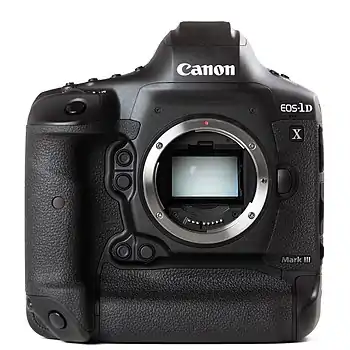 | |
| Overview | |
|---|---|
| Type | Digital single-lens reflex camera |
| Released | January 2020 |
| Lens | |
| Lens | Interchangeable (EF) |
| Sensor/medium | |
| Sensor type | CMOS |
| Sensor size | 36.0 × 24.0 mm (Full-frame) |
| Maximum resolution | 5472 × 3648 (20.0 effective megapixels) |
| Film speed | 100 – 102400 (expandable from L: 50 to H1: 204800; H2: 409600; H3: 819200) |
| Storage media | Dual slots: CFexpress card |
| Focusing | |
| Focus modes | One-Shot, AI Servo, Manual |
| Focus areas | 191 AF points (155 cross-type AF points) |
| Exposure/metering | |
| Exposure modes | Program AE, Shutter priority AE, Aperture priority AE, Manual exposure, Bulb exposure, Custom |
| Exposure metering | approx. 400,000 pixel RGB+IR sensor |
| Flash | |
| Flash | External |
| Shutter | |
| Shutter | Electromechanical carbon fiber focal-plane |
| Shutter speed range | 1/8000 s – 30 s, Bulb; X-sync at 1/250 s |
| Continuous shooting | 16 fps with full AF/AE tracking; 20 fps in Live View mode |
| Viewfinder | |
| Viewfinder | Eye-level pentaprism with 100% coverage and 0.76x magnification / LCD (Live View) |
| Image processing | |
| Image processor | DIGIC X |
| White balance | Available |
| WB bracketing | Available |
| General | |
| Video recording | 5.5K RAW (5472 x 2886), 59.94 fps |
| LCD screen | 80.1 mm (3.15 in) TFT LCD touchscreen with 2,100,000 dots |
| Battery | LP-E19 |
| Body features | Dust and weather sealed magnesium alloy |
| Dimensions | 167.6 mm × 158 mm × 82.6 mm (6.60 in × 6.22 in × 3.25 in) |
| Weight | 1,440 g (3.17 lb) including battery and CFexpress card, body only |
| Made in | Japan |
| Chronology | |
| Replaced | Canon EOS-1D X Mark II[1] |
The Canon EOS-1D X Mark III is the company's 20-megapixel full-frame DSLR flagship camera, announced on January 6, 2020, by Canon. It is the successor to the Canon EOS-1D X Mark II, which was released on February 1, 2016.[2]
The camera will reportedly be Canon's final flagship DSLR, as the company shifts entirely to mirrorless cameras.[3]
Features
New features over the Canon EOS-1D X Mark II are:
- 5.5k (5472 × 2886) with up to 60 fps (59.94 fps)[4]
- Continuous shooting rate of up to 16 frames per second with full autofocus; 20 fps in live view.[4]
- 191 AF points support[4]
- Dual CFexpress card slots (as opposed to one Compact Flash and one CFast slot in EOS-1D X Mark II)[4]
- ISO range up to 102400 (Extended H3 up to 819200)[4]
- Support for HDR PQ still photo shooting in High Efficiency Image File Format (HEIF) compliant with Rec. 2100 color space (PQ transfer function, Rec. 2020 color primaries, 10 bit depth, 4:2:2 YCbCr subsampling)[4][5][6]
References
- ↑ "EOS-1D X Mark II". Canon Camera Museum.
- ↑ "A Masterpiece In Engineering And Design: Canon Announces The EOS-1D X Mark III Camera". 2020-01-07. Retrieved 2020-02-01.
- ↑ Lawler, Richard (2021-12-30). "Canon's flagship DSLR line will end with the EOS-1D X Mark III, eventually". The Verge. Retrieved 2022-01-05.
- 1 2 3 4 5 6 "Specifications" (PDF). Retrieved 2020-02-01.
- ↑ Europe, Canon. "Specifications & Features - EOS-1D X Mark III". Canon Europe. Retrieved 2021-02-15.
- ↑ "HDR PQ HEIF: Breaking Through the Limits of JPEG". SNAPSHOT - Canon Singapore Pte. Ltd. Retrieved 2021-02-15.
External links
 Media related to Canon EOS-1D X Mark III at Wikimedia Commons
Media related to Canon EOS-1D X Mark III at Wikimedia Commons- Official web page
- Sample Images & Movies
This article is issued from Wikipedia. The text is licensed under Creative Commons - Attribution - Sharealike. Additional terms may apply for the media files.